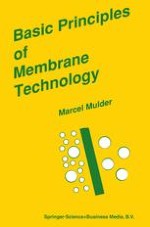1991 | Buch
Über dieses Buch
Membranes playa central role in our daily life, or as indicated by one of my foreign colleagues, Richard Bowen, 'If you are tired of membranes, you are tired of life' . Biological membranes are hardly used in industrial applications, but separations with synthetic membranes have become increasingly important. Today, membrane processes are used in a wide range of applications and their numbers will certainly increase. Therefore, there is a need for well educated and qualified engineers, chemists, scientists and technicians who have been taught the basic principles of membrane technology. However, despite the growing importance of membrane processes, there are only a few universities that include membrane technology in their regular curricula. One of the reasons for this may be the lack of a comprehensive textbook. For me, this was one of the driving forces for writing a textbook on the basic principles of membrane technology which provides a broad view on the various aspects of membrane technology. I realise that membrane technology covers a broad field but nevertheless I have tried to describe the basic principles of the various disciplines. Although the book was written with the student in mind it can also serve as a first introduction for engineers, chemists, and technicians in all kind of industries who wish to learn the basics of membrane technology.
Anzeige
